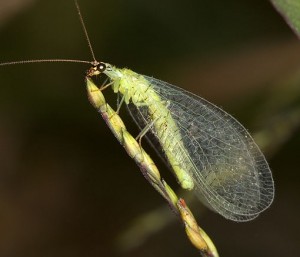I figured if I am going to do a review of genetically engineered crops, I needed to address the other major traits besides resistance to herbicides presently on the market. This one addresses a family of proteins found in the bacteria Bacillus thuringiensis that can kill insects.
Anyone who reads about the public policy debates swirreling around genetically engineered crops will be familar with the two letter abbreviation ‘bt’ as in bt corn, bt cotton, bt ginseng (the last is fictional). What always surprises me is that some people STOP reading before they come across an explanation of what bt stands for. Just typing bt into google won’t bring up a relevant result until the 30th hit (two letters just isn’t very unique). I have talked with people who are convinced bt stands for everything from biologically treated to BioToxin. It doesn’t.

Golden Eyed Lacewing Adult. It's not much use, but the larva vicious predators of certain plant pests. (Photo public domain courtesy of USDA. You guys are awesome!)
The name actually comes from a species of bacteria called Bacillus thuringiensis. Different substrains of the species carry different members of a family of genes that code for Cry proteins (and separately can also carry genes that code for Cyt proteins*), which can kill insects. Finding chemical or biological means to kill insects isn’t that hard. What makes the Cry proteins noteworthy is how selective they are in their killing. A given Cry protein is dangerous to only a small subset of insect species. And that’s important, because, for every** western corn rootworm, european corn borer, or earworm there are also benign or even beneficial insects in and around fields like lacewings, trichogramma wasps, or those rootworm eating nematodes I talked about a couple of days ago, which aren’t insects, but also harmed by insecticides. (Agro-ecology is beyond my field of expertise, had to call up my tipster from the previous post to get this list) When a crop is genetically engineered to produce one of the dozens of Cry proteins discovered in Bacillus thuringiensis, it replaces or reduces the spraying of insecticides to control insect pests, with positive effects on insect biodiversity. (more…)